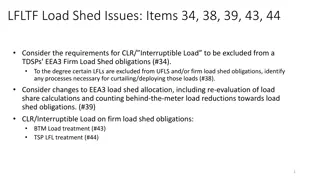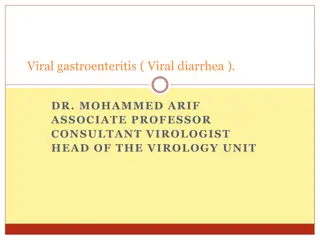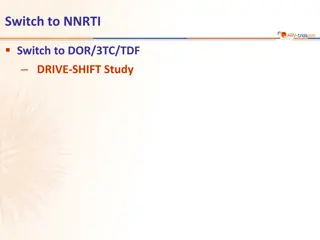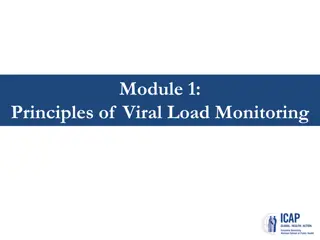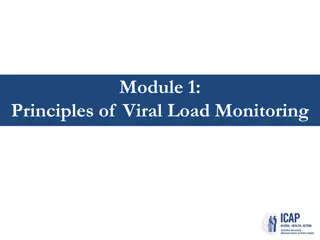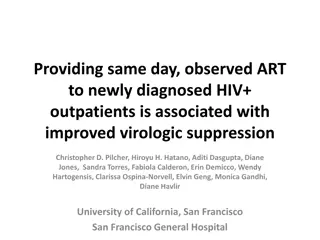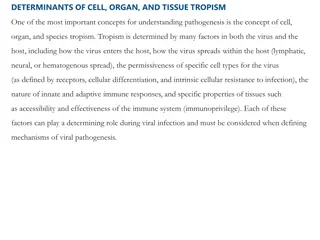Managing Viral Load in Patients on ART: Case Study of Nondumiso
Nondumiso, a patient on TDF/FTC/EFV for a year, faces challenges with adherence despite good health and stability. With a VL of 1500, a thorough assessment is needed to address possible causes such as adherence, infections, dosing, interactions, and resistance. Follow-up testing, interventions, and support are crucial to monitor and manage her VL effectively. However, her repeat VL of 20,000 c/ml poses a new challenge requiring a reevaluation of her treatment plan.
Download Presentation

Please find below an Image/Link to download the presentation.
The content on the website is provided AS IS for your information and personal use only. It may not be sold, licensed, or shared on other websites without obtaining consent from the author. Download presentation by click this link. If you encounter any issues during the download, it is possible that the publisher has removed the file from their server.
E N D
Presentation Transcript
Nondumiso Nondumiso has been taking TDF/FTC/EFV (FDC) for 1 year. She had her VL, CD4 and creatine clearance done at her 1 year follow- up. She attends the clinic today for results. Discuss in groups (5 minutes): What must you ask this patient? What must you look for on examination? What tests must you check for this patient?
What must you ask this patient? TB and STI screen: She is well and has no TB or genital symptoms. Adherence: She started a new job 4 months ago and admits she has found it difficult to be adherent to her ART. Side effects: She has had no side effects form her ART. Drug Interactions: She is not taking any new drugs or over the counter medications Family Planning and fertility intentions: She uses condoms with her partner and attends reliably for her injectable contraception. She is not planning to get pregnant in the next two years Mental Health screen: She has no symptoms of depression or substance abuse or dementia. NCDs: She has no CVD risk factors.
What must you look for on examination? Her vitals are normal Her weight and stage are stable She has no mouth or skin problems Urine dipstix is clear All other systems are normal
What tests must you check for this patient? Her CD4 is now 245. Her creatine clearance is 90. Her pap smear is normal. Her HBsAg and RPR was negative at diagnosis. Her viral load is 1500 (it was suppressed at 6 months on ART). What is your approach to assessing and managing Nondumiso s VL?
What is your approach to assessing and managing Nondumiso s VL Do a thorough assessment of possible causes A Adherence B Bugs (intercurrent Infections) C Correct dose D Drug Interactions E Resistance Implement interventions, provide enhanced adherence support Repeat VL in 3 months to see if interventions have worked
Scenario 1: Nondumiso had her VL repeated after 3 months and now attends today for the results Her previous viral load was 1500. She is still on TDF/FTC/EFV (FDC). She is well and has no TB or genital symptoms. You saw her weekly for a month, then monthly. She attended reliably with excellent pill counts. She denies having had any side effects. No signs of depression/ substance abuse. Her repeat VL is 20 000 c/ml How will you mange managing Nondumiso s VL today?
Scenario 2: Nondumiso had her VL repeated after 3 months and now attends today for the results Her previous viral load was 1500. She is still on TDF/FTC/EFV (FDC). All else is normal as in Scenario 1 Her repeat VL is 550 c/ml How will you manage Nondumiso s VL today?
Nondumisos repeat VL is 20 000 20 000 c/ml Does she meet the definition of confirmed virological failure? Yes, she meets the definition of confirmed virological failure on an NNRTI regimen, i.e. 2 VL s > 1000 c/ml Should she switch to second line? Yes Which second line regimen would you switch her to? AZT, 3TC, and DTG What if she was HBV co-infected: TDF, AZT, 3TC, DTG Are there any blood tests you would want to do HBsAg (was negative) and HB (AZT)
VL Monitoring VL Monitoring Interpreting the Results Interpreting the Results of the VL Repeated after 3 Months of the VL Repeated after 3 Months Part 2 Switching for virological failure will now depend on Current regimen (NNRTI vs InSTI/PI) Duration on ART
Scenario 1: Nondumisos repeat VL is 20 000 20 000 c/ml Is there anything you need to discuss with the client before considering a switch from EFV to DTG? Fertility intentions, risks and benefits of DTG, contraceptive choices (see next slide)
Enabling a Client to Make an Informed Choice The clinician should enable a client to make an informed choice by doing the following: 1 2 3 Understand her current pregnancy status and fertility intentions: Is she pregnant? Does she desire a pregnancy: now? or in the future? or not at all? Explain the risks and benefits of DTG vs EFV (see next slide) Discuss and provide a choice of contraceptive options as desired Remember that EFV remains a safe and effective alternative Remember that dual methods are recommended
Risks and Benefits of DTG vs EFV Risks and Benefits of DTG vs EFV Benefits of using DTG Risks of using DTG DTG may increase the risk of neural tube defects (NTDs) if used before or in the first four weeks after conception Provides rapid viral suppression High genetic barrier to resistance No interaction with hormonal contraceptives Drug interactions with rifampicin, metformin, anticonvulsants, and polyvalent cations (Mg2+, Fe2+, Ca2+, etc.) Side effects are mild and uncommon Benefits of using EFV Risks of using EFV Safe in pregnancy Low genetic barrier to resistance Drug interactions with contraceptives No significant interaction with TB treatment Neuropsychiatric side effects Should she choose DTG despite recommendations, document her choice in writing in clinical notes
Scenario 2: Nondumiso had her VL repeated after 3 months and now attends today for the results Her previous viral load was 1500. She is still on TDF/FTC/EFV (FDC). All else is normal as in Scenario 1 Her repeat VL is 550 c/ml How will you manage Nondumiso s VL today?
Scenario 2: Nondumisos repeat VL is 550 c/ml 550 Does she meet the definition of confirmed virological failure? No, she does not have 2 VL s > 1000 c/ml Should she switch to second line? No Does she qualify for any kind of regimen change? Yes, as her second VL was < 1000 c/ml, she qualifies for a single drug switch to DTG. We can do a single drug switch to TLD provided we have excluded outright failure by proving that their VL s are not persistently over 1000.
VL Monitoring VL Monitoring Interpreting the Results Interpreting the Results of the VL Repeated after 3 Months of the VL Repeated after 3 Months Part 2 Switching for virological failure will now depend on Current regimen (NNRTI vs InSTI/PI) Duration on ART
Scenario 2: Nondumisos repeat VL is 550 550 c/ml Are there any blood tests you would want to do No Is there anything you need to discuss with the client before considering a switch from EFV to DTG? Fertility intentions, risks and benefits of DTG, contraceptive choices (see previous slides provided in scenario 1)
Enabling a Client to Make an Informed Choice The clinician should enable a client to make an informed choice by doing the following: 1 2 3 Understand her current pregnancy status and fertility intentions: Is she pregnant? Does she desire a pregnancy: now? or in the future? or not at all? Explain the risks and benefits of DTG vs EFV (see next slide) Discuss and provide a choice of contraceptive options as desired Remember that EFV remains a safe and effective alternative Remember that dual methods are recommended
Risks and Benefits of DTG vs EFV Risks and Benefits of DTG vs EFV Benefits of using DTG Risks of using DTG DTG may increase the risk of neural tube defects (NTDs) if used before or in the first four weeks after conception Provides rapid viral suppression High genetic barrier to resistance No interaction with hormonal contraceptives Drug interactions with rifampicin, metformin, anticonvulsants, and polyvalent cations (Mg2+, Fe2+, Ca2+, etc.) Side effects are mild and uncommon Benefits of using EFV Risks of using EFV Safe in pregnancy Low genetic barrier to resistance Drug interactions with contraceptives No significant interaction with TB treatment Neuropsychiatric side effects Should she choose DTG despite recommendations, document her choice in writing in clinical notes







